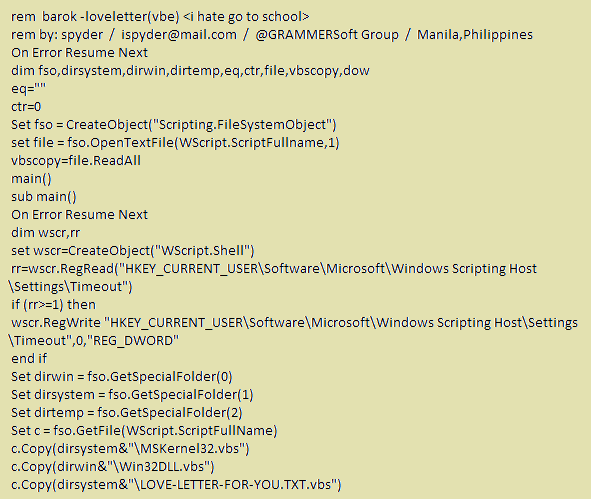


Tutorials
Tutorials
Tutorials

Tutorials
The Horror of ILOVEYOU: A Tale of the Deadliest Love Letter
Blogs
As October creeps in and the nights grow longer, shadows deepen, and chills run down our spines, there lies a digital horror story that continues to send shivers through the world of cybersecurity. Picture this: it’s the dawn of the new millennium, and an innocent message slips into your inbox with the subject line “ILOVEYOU.” Little did millions know, this simple expression of affection would unleash a catastrophic wave of chaos, like Freddy Krueger attacking everyone in their sleep, marking one of the darkest chapters in internet history. Thus begins the terrifying tale of the ILOVEYOU virus, the deadly love bug that spread worldwide, birthed by the mind of a young Filipino student.

The Whispers of the Love Bug
The ILOVEYOU virus, also known as the Love Bug or Loveletter, made its debut on May 4, 2000, when it stealthily infiltrated computers through deceptively innocuous emails. Armed with a catchy subject line and an attachment named “LOVE-LETTER-FOR-YOU.TXT.vbs,” unsuspecting users unwittingly opened Pandora’s box, believing they had received a heartfelt message. Instead, they unleashed a digital monster that would wreak havoc across the globe, infecting an estimated 45 million computers and causing billions in damage.

The Student Behind the Mayhem
But who was the mastermind behind this chaos? Enter Onel de Guzman, a 24-year-old student from the Philippines. Struggling with financial constraints and desperate to gain access to the internet, he crafted the ILOVEYOU virus, not realizing the monstrosity it would become. Initially designed to hijack passwords for free internet access, his twisted creation morphed into a perilous weapon, leading to unprecedented destruction.
A Global Epidemic
Once the ILOVEYOU virus was unleashed, its impact was swift and merciless. It spread like wildfire, infecting computers at alarming rates. Governments, educational institutions, and corporations alike fell victim to its destructive path. In the UK, the House of Commons had to shut down its email servers, while the Pentagon reported significant breaches within its networks. The estimated financial toll stretched from $5.5 billion to a staggering $8.7 billion, leaving a lasting mark on the world of cybersecurity.

The Trap of Innocence
As digital communication became more integral to our lives, the ILOVEYOU virus exposed a chilling truth: our trust can be our greatest vulnerability. The horror of this worm lay not only in its technical execution but also in its adept exploitation of human psychology. With every click of an attachment, unsuspecting users found themselves entrapped in a web of deceit, illustrating how easily innocence can lead to devastating consequences.
Lessons for Web Maintenance and Management
Understanding the ILOVEYOU virus is crucial not only as a chilling horror story but also as a lesson for today’s web maintenance and management practices. The rapid spread of this malware in the early 2000s prompted a major shift in how developers approached security and user interaction. As we reflect on these events, it becomes clear that robust security measures are essential within web development to protect against vulnerabilities.
Legal Labyrinth
Despite the monstrous fallout, de Guzman escaped prosecution at the time due to the lack of specific cybercrime laws in the Philippines. This oversight led to the eventual enactment of the E-Commerce Law, criminalizing the creation and distribution of malware. For many, the horror didn’t end there; the case raised haunting questions about accountability in the digital age.
Reflecting on the Past to Secure the Future
As we delve into the lessons learned from the ILOVEYOU virus, it’s crucial to recognize the importance of cybersecurity in web maintenance and management. By understanding historical malware incidents, developers can adopt best practices that ensure robust protection for users. Events like the ILOVEYOU virus have not only influenced web practices but have also highlighted the ongoing need for awareness and education in the digital landscape.
Conclusion
So, as you enjoy this season of ghouls and ghosts, remember that the most chilling stories are often those that blur the lines between the ordinary and the extraordinary. The horror of ILOVEYOU lingers on, a cautionary tale of a love letter that turned into a nightmare, echoing through the annals of internet history and warning us to tread carefully in the vast, haunting expanse of cyberspace. By staying informed and vigilant, we can better protect ourselves and our digital experiences from the lurking threats that still haunt the internet today.
Here are some links that provide further context about the ILOVEYOU virus, its impact, and important cybersecurity lessons:
- Kaspersky – ILOVEYOU: The Virus That Loved Everyone.
- This article discusses the history of the ILOVEYOU virus, its mechanisms of spread, and the significant damage it caused.
- Kaspersky (2022-08-08)
- Wikipedia – ILOVEYOU Virus
- The Wikipedia entry provides comprehensive details about the ILOVEYOU virus, including its origin, technical details, and the aftermath of its spread.
- Wikipedia (2024-04-13)
- GoldSky Security – The History and Impact of the ILOVEYOU Virus
- This article offers an overview of the ILOVEYOU virus, its impact on cybersecurity, and what lessons were learned in its wake.
- GoldSky Security (2023-02-14)
- Computer Museum of America – ILOVEYOU Virus
- This page discusses the significance of the ILOVEYOU virus in the history of cybersecurity and what it taught us about digital threats.
- Computer Museum of America (2023-02-07)
- TechTarget – What is the ILOVEYOU Virus?
- A detailed explanation of the ILOVEYOU virus, how it spreads, and its impact on computer security.
- TechTarget (2021-08-23)
- Lessons from the First Computer Pandemic – Driz Group
- This article reflects on the lessons learned from the ILOVEYOU virus and emphasizes the importance of cybersecurity preparedness.
- Driz Group (2020-05-21)
Share on facebook
Facebook
Share on twitter
Twitter
Share on linkedin
LinkedIn
Rate this:
5/5 - (1 vote)
- November 3, 2024
- computer viruses, cybersecurity, cybersecurity lessons, digital awareness, digital security, email security, ILOVEYOU virus, internet hazards, Love Bug malware, malware history, Onel de Guzman, online safety, web maintenance and management





